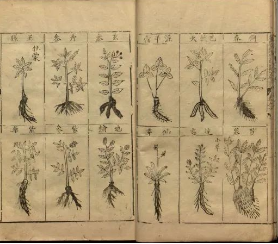
The Compendium of Materia Medica was published in the 24th year of Wanli (1596) during the Ming Dynasty in China. This book is considered a masterpiece in medicine, contributing significantly to human survival and development, health, and happiness.
To ensure accuracy and reliability, its author, Li Shizhen (1518-1593), personally inspected, traveled thousands of miles, read extensively, corrected errors, and referenced over 800 ancient books. The book includes 1892 kinds of medicines, with more than 1,000 illustrations and 10,000 prescriptions. After its publication, it was translated into many languages including Latin, Japanese, French, German, Italian, English, Russian, Korean, and more. Darwin even called it the “Encyclopedia of Ancient China”. In 2011, it was selected into the Memory of the World Register.
Since ancient times, many drugs have been used to treat diseases, including plants, animals, and minerals. The roots and grasses were the most commonly used plant materials. In ancient Chinese, “Ben” meant “Root”, so “Bencao” represented herb medicine. “Gang” referred to the main rope of a fishing net, and “Mu” was the mesh (网眼). Grasping the main rope controlled the mesh. Thus, “Gang Ju Mu Zhang” described grasping key points and being organized. This concept was applied to book writing, forming the “Outline Style”. The structure sets up a general outline or category and detailed items under each outline. So, “Compendium of Materia Medica” literally means a drug book written in an outline style. Since items always follow the outline, it’s called “Bencao Gangmu” in Chinese, or “Compendium of Materia Medica” in English.
There are 52 volumes in the Compendium of Materia Medica. The first two volumes explained the properties, principles, and usage methods of medicines. They combined theories from Shennong’s Classic of Material Medica (Shennong Bencao Jing) with views from various scholars and later developments. The next two volumes listed diseases as main topics and used dialectical medicine for each item. Medicines were grouped by their properties and uses, helping doctors choose the right drugs for specific symptoms. This approach highlighted the importance of tailored treatments. Volumes 5 to 52 introduced 1892 medicinal materials, one by one.
原创编写 版权所有 侵权必究! 每日更新 个性化阅读 英语飙升!
1.1.What can we learn about the Compendium of Materia Medica from the Para.2?
A Li Shizhen wrote it during the Qing Dynasty.
B It mainly talks about culture and education.
C Li Shizhen witnessed the publication of it.
D It was well-known in China and abroad.
解析:选D。1.推理判断题。结合第二段最后两句“After its publication, it was translated into many languages including Latin, Japanese, French, German, Italian, English, Russian, and more. Darwin even called it the ‘Encyclopedia of Ancient China.’ In 2011, it was selected into the Memory of the World Register. ”《本草纲目》出版后被译成拉丁、日、法、德、意、英、俄等多种文字在国外出版,被达尔文称为 “中国古代的百科全书”,2011年入选《世界记忆名录》。可知,《本草纲目》享誉国内外。故选D。
2.2.What’s the third paragraph mainly about?
A Life of the author of the Compendium of Materia Medica.
B What is written in the book of the Compendium of Materia Medica.
C How the book of the Compendium of Materia Medica got its name.
D Why the book of the Compendium of Materia Medica is of great importance.
解析:选C。C 段落大意题。根据第三段中的“Since items always follow the outline, it’s called ‘Bencao Gangmu’ in Chinese, or ‘Compendium of Materia Medica’ in English.”可知,该段主要介绍的是《本草纲目》名字的由来。故选C。
3.3.In which volume might we read about stomachache?
A Before the first volume.
B In the first and second volumes.
C In the third and fourth volumes.
D In volume 5 and beyond.
解析:选C。C 细节理解题。根据最后一段中的“The next two volumes listed diseases as main topics and used dialectical medicine for each item...”可知第三、四卷为“百病主治”,以病名为纲,以辨证用药为目,把药物按其性能和主治进行分类,为医者临床辨证选药提供了方便,同时也体现了辨证论治的精神。因此读者可能在第三四卷中读到关于腹痛这一症状的相关内容。故选C。
4.4.The purpose of the text is ______.
A to introduce
B to advertise
C to entertain
D to persuade
解析:选A。A 推理判断题。根据全文内容可知,文章主要介绍了中国医药学巨著《本草纲目》的相关内容。故选A。
